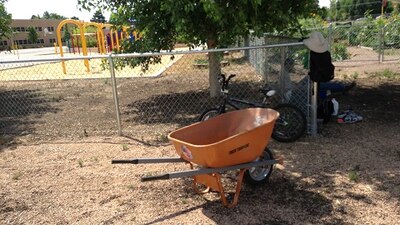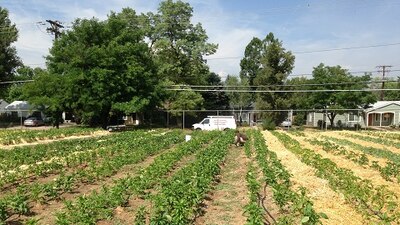Half a dozen workers crouched in the field mounding hay around organic bell pepper and zucchini plants as the morning sun beat down on a recent summer day.
With their work boots, gloves and brimmed hats, they looked a lot like farmers anywhere else in the Colorado’s rural expanse. The difference is these workers were toiling away on a one-acre plot at Bradley International School in southwest Denver, their shovels and wheelbarrows a hundred feet away from the school’s bright yellow swing set.
The farm, one of three on Denver Public Schools grounds, is part of the district’s pilot farm-to-school program, which converts unused school land into working farms that produce tens of thousands of pounds of produce for school cafeterias. In addition to the farm at Bradley, which was established in 2012, there are farms at Schmitt Elementary and Denver Green School. There’s also a farm at McGlone Elementary School, but it’s on hiatus this summer while construction occurs there.
“This is the beginning,” Anne Wilson, the district’s farm-to-school coordinator, said of the district’s recent plunge into urban agriculture. “Certainly, we hope to look at doing more sites in the future.”
School farms rare
The DPS school farm project appears to be one of the first of its kind, at least in Colorado. Jeremy West, nutrition service director for Weld County District 6 and chairman of the Colorado Farm to School Task Force, said he’s not aware of other districts that have similar programs.

“I would say they’re pretty unique,” said West. “I think they’re…on the forefront of having urban farming on their property.”
While over 60 Colorado schools or districts have some type of farm-to-school initiative, he said, it often takes the form of buying fruits and vegetables from local growers, not raising hundreds of tons of produce at the schools themselves.
While not quite on the scale of Denver’s farm program, Colorado Springs District 11 does grow about 1,500 pounds of produce a year, including lettuce, carrots, tomatoes, squash, spinach and herbs in a greenhouse and five raised beds at Galileo School of Math and Science. The produce is used at Galileo as well as cafeterias throughout the district.
In DPS, the school farms are not to be confused with school gardens, which exist at many Denver schools, including Bradley. While the smaller-scale gardens may contribute some produce to school salad bars, they are typically more of an educational tool with school and community volunteers responsible for their upkeep.
The farms, by contrast, are focused on production with contractors in charge of their operation and extensive protocols for food safety.
Produce Denver, an urban agriculture company, is the contractor at Bradley and Schmitt, as well as three non-school sites in Denver, including the Colorado Convention Center. This year, the two school farms are expected to yield about 1,000 pounds of tomatoes and bell peppers a week, 600 pounds of cucumbers and 400 pounds of zucchini a week from late August to late October. The zucchini and bell pepper crop will completely satisfy the district’s weekly needs during that period. The tomatoes will satisfy only about one-third of the district’s weekly needs and the cucumbers only one-fifth.
Denver Green School, which partners with Sprout City Farms to run its one-acre vegetable and herb farm, doesn’t contribute its 11,000-pound annual produce yield for districtwide cafeteria use. However, about half of that is used to cover most of the school’s vegetable needs during the fall. The other half is sold at the school’s farm stand, used in its community-supported agriculture program or donated to emergency food programs.
Gardens gave birth to farms
Many Denver elementary schools built gardens on their campuses through the Learning Landscape Initiative, funded with private and bond money over the past 13 years. At schools like Bradley, Schmitt and McGlone, there was enough unused space to consider bigger plots as well. At Bradley, for example, the school garden adjacent to the playground was green and thriving, but the northeast corner of the school’s property was empty save for a layer of pea gravel and an unused backstop.
“It was a prison yard,” said Alethea McClure, a health paraprofessional at the school and regular garden volunteer. “It was horrible,”
Wilson said, “What started us on working with the farms and bringing the food into cafeterias was school gardens. We had these beautiful school gardens producing all this fabulous produce…We sat down and came up with a protocol that would address the food safety concerns.”
Wilson said Slow Food Denver, a non-profit that promotes local and sustainable foods, helped develop that protocol and has been a key partner in the farm project.
Students now get to experience the growing process first hand in the school’s garden, and see the larger-scale farm operation unfold a stone’s throw away. To Wilson and McClure, the garden and farm are natural companions.
McClure, who has two daughters attending Bradley, said it’s important “for our kids to see that…food comes from somewhere. It doesn’t come from a truck.”
She added, “They’re so proud because in our salad bar…they know there’s a chance it was grown here.”
Grade-schoolers aren’t the only ones who see the farm-to-school process for themselves. Several Denver area teens are paid to work at the Bradley and Schmitt farms through an organization that partners with Produce Denver. It’s called Groundworks Denver and focuses on making urban environmental improvements.
Vitto Moscoso, who is going into 11th grade at Career Education Center Middle College of Denver, took a break from his work in a row of zucchini plants to talk about his farm job.
“I like working outdoors,” he said. It’s also nice “knowing it’s going to the schools.”
Future DPS farms
District leaders already know there’s room for more school farms in Denver. Wilson said a study funded by the Colorado Health Foundation a couple years found that there were about 18 acres of farmable land in the district at the time.

“There’s acres and acres of land that isn’t needed, that’s maybe either pea gravel or turf that isn’t being used by the kids and isn’t being used for athletics,” said Wilson.
Still, vacant land and the demand for produce in the 84,000-student district aren’t the only variables in the equation. There’s also the cost of setting up new irrigation systems, buying seeds and paying for labor.
“There is an upfront cost and that’s why we’re not doing 18 acres tomorrow,” said Wilson.
She said it’s too early in the farm project to determine if harvesting produce from campus farms save the district money.
“We’ll be better able to answer that question in a few years,” she said. “Certainly, we want to make sure it’s financially sustainable over the long haul.”
Future school building expansion is another factor that may affect the long-term trajectory of the farm project, potentially eating into the acreage identified in the Colorado Health Foundation study.
A nearly $100,000 grant recently awarded to the district by the U.S. Department of Agriculture will help the district map out its farming future. In addition to helping create a strategic plan, the grant will fund additional food safety initiatives, consultations about future farm sites as well as menu-planning and recipe-testing efforts.
Wilson said until the district creates more farmland, the food service department will have to supplement district-grown crops like tomatoes and cucumbers with produce from vendors.
Even so, she said, “It’s exciting because it still will reach all the schools we service.”
